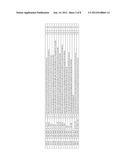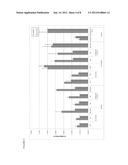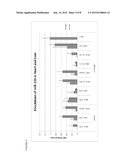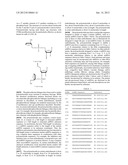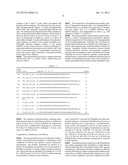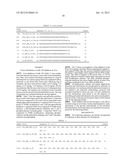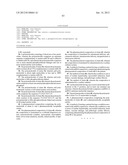Patent application title: CHEMICAL MODIFICATIONS MOTIFS FOR MIRNA INHIBITORS AND MIMETICS
Inventors:
Christina Dalby (Boulder, CO, US)
William S. Marshall (Boulder, CO, US)
Assignees:
Miragen Therapeutics
IPC8 Class: AA61K317088FI
USPC Class:
424450
Class name: Drug, bio-affecting and body treating compositions preparations characterized by special physical form liposomes
Publication date: 2012-06-14
Patent application number: 20120148664
Abstract:
The present invention provides polynucleotides having chemistry patterns
that provide for improved stability, potency, and/or toxicity relative to
their use as miRNA inhibitors or miRNA mimetics. The invention further
provides pharmaceutical compositions and formulations comprising the
polynucleotides, and methods for treating patients having a condition
associated with miRNA or mRNA expression.Claims:
1-33. (canceled)
34. A polynucleotide consisting of about ten or less nucleotides, wherein the polynucleotide comprises an antisense sequence complementary to mature miR15b and is effective to inhibit miR15b, and wherein the polynucleotide comprises one or more internal phosphorothioate linkages and one or more locked nucleic acid residues.
35. The polynucleotide of claim 34, wherein the polynucleotide is at least about 75% complementary to mature miR15b.
36. The polynucleotide of claim 34, wherein said polynucleotide is about eight nucleotides or less and is 100% complementary to mature miR15b.
37. The polynucleotide of claim 34, wherein said polynucleotide is fully phosphorothioate-linked.
38. The polynucleotide of claim 34, wherein the polynucleotide comprises at least one terminal phosphorothioate monophosphate.
39. The polynucleotide of claim 34, wherein said polynucleotide consists of all locked nucleic acid residues.
40. The polynucleotide of claim 34, wherein the polynucleotide comprises the sequence 5'-GTGCTGCT-3'.
41. The polynucleotide of claim 34, wherein the polynucleotide consists of the sequence 5'-GTGCTGCT-3', and the polynucleotide is fully phosphorothioate linked and consists of all locked nucleic acids.
42. A pharmaceutical composition comprising the polynucleotide of claim 1, and a pharmaceutically acceptable carrier.
43. The pharmaceutical composition of claim 42, wherein the composition is formulated as a colloidal dispersion system, macromolecular complex, nanocapsule, microsphere, bead, oil-in-water emulsion, micelle, mixed micelle, or liposome.
44. The pharmaceutical composition of claim 42, wherein the composition is formulated for intradermal delivery, subcutaneous delivery, intramuscular delivery, intraperitoneal or intravenous delivery.
45. The pharmaceutical composition of claim 42, wherein the composition is formulated for administration by a cardiac catheter system.
46. A method of treating a patient having a condition associated with miRNA expression, comprising administering the pharmaceutical composition of claim 42 to the patient.
47. The method of claim 46, wherein the condition is one or more of cardiac hypertrophy, myocardial infarction, heart failure, vascular damage, and pathologic cardiac fibrosis.
48. The method of claim 46, wherein the composition is administered by a cardiac catheter.
49. A polynucleotide having one or more nucleotide modifications at the 2' position, and at least one terminal cap structure, wherein the polynucleotide comprises a miRNA or miRNA antisense nucleotide sequence.
50. The polynucleotide of claim 49, wherein the polynucleotide is from 5 to 25 nucleotides in length.
51. A pharmaceutical composition comprising the polynucleotide of claim 49, and a pharmaceutically acceptable carrier.
52. A method of treating a patient having a condition associated with miRNA expression, wherein the condition is one or more of cardiac hypertrophy, myocardial infarction, heart failure, vascular damage, and pathologic cardiac fibrosis, comprising administering the pharmaceutical composition of claim 51 to the patient.
Description:
CROSS-REFERENCE TO RELATED APPLICATIONS
[0001] This application claims the benefit of priority of U.S. Provisional Application No. 61/185,033, filed Jun. 8, 2009, which is hereby incorporated by reference in its entirety.
FIELD OF THE INVENTION
[0002] The present invention relates to chemical motifs for microRNA (miRNA or miR) inhibitors and mimetics, and particularly to chemically modified miRNA sense and antisense polynucleotides having advantages in potency, stability, and/or toxicity when administered to a patient.
BACKGROUND
[0003] MicroRNAs (miRs) have been implicated in a number of biological processes including regulation and maintenance of cardiac function (see, Chien K R, Molecular Medicine: MicroRNAs and the tell-tale heart, Nature 447, 389-390 (2007)). Therefore, miRs represent a relatively new class of therapeutic targets for conditions such as cardiac hypertrophy, myocardial infarction, heart failure, vascular damage, and pathologic cardiac fibrosis, among others. miRs are small, non-protein coding RNAs of about 18 to about 25 nucleotides in length, and act as repressors of target mRNAs by promoting their degradation, when their sequences are perfectly complementary, or by inhibiting translation, when their sequences contain mismatches. The mature miRNA strand is incorporated into the RNA-induced silencing complex (RISC), where it associates with its target RNAs by base-pair complementarity.
[0004] miRNA function may be targeted therapeutically by antisense polynucleotides or by polynucleotides that mimic miRNA function ("miRNA mimetic"). However, when polynucleotides are introduced into intact cells they are attacked and degraded by nucleases leading to a loss of activity. While polynucleotide analogues have been prepared in an attempt to avoid their degradation, e.g. by means of 2' substitutions (B. Sproat et al., Nucleic Acids Research 17 (1989), 3373-3386), the modifications often affect the polynucleotide's potency for its intended biological action. Such reduced potency, in each case, may be due to an inability of the modified polynucleotide to form a stable duplex with the target RNA and/or a loss of interaction with the cellular machinery.
[0005] Chemistry patterns or motifs for improving the stability, potency and/or toxicity profile of miRNA inhibitors and miRNA mimetics are needed for effectively targeting miRNA function in a therapeutic context.
SUMMARY OF THE INVENTION
[0006] The present invention provides polynucleotides having chemistry patterns that provide for improved stability, potency, and/or toxicity relative to their use as miRNA inhibitors or miRNA mimetics. The invention further provides pharmaceutical compositions and formulations comprising the polynucleotides, and methods for treating patients having a condition associated with miRNA or mRNA expression.
[0007] In one aspect, the invention provides a polynucleotide having one or more nucleotide modifications at 2' positions, and at least one terminal or "cap" modification. The chemical modification motif may obviate the need for fully phosphorothioate-linked polynucleotides and/or full length antisense or sense miRNA sequences. The polynucleotide is a miRNA inhibitor or miRNA mimetic, and as shown herein, provides an improved potency over unmodified polyribonucleotides, and/or over other potential polynucleotide modifications.
[0008] For example, the polynucleotide may be a miRNA inhibitor or miRNA mimetic having one or a combination of 2' modifications as described herein, such as those selected from O-alkyl (e.g., 0-methyl or "OMe"), halo (e.g., fluoro), deoxy (H), and locked nucleic acid, and in some embodiments, substantially all, or all, nucleotide 2' positions are modified. The terminal or cap modification may be, in some embodiments, a 5' and/or 3' phosphorothioate monophosphate and/or abasic moiety, or other cap structure as described herein. The polynucleotide need not be fully phosphorothioate linked, but where such linkages are present, such linkages may be placed, for example, between the two terminal nucleotides on the 5' end and the two terminal nucleotides on the 3' end. The nucleotide sequence may be full length relative to a mature miRNA or full length antisense miRNA (mature form), but in some embodiments the polynucleotide comprises a truncated miRNA sequence or a truncated miRNA antisense sequence. Such modified truncated sequences may show high levels of potency, even when compared with longer (unmodified or conventionally modified) counterparts. The polynucleotide may be an antagomir having an antisense sequence complementary to (all or portions of) miR-15b, miR-21, miR-208a, or others as described herein.
[0009] In a second aspect, the invention provides a pharmaceutical composition or formulation comprising the polynucleotide of the invention, and a pharmaceutically acceptable carrier. The pharmaceutical composition may be formulated in a variety of pharmaceutically-acceptable forms, including colloidal dispersion system, macromolecular complex, nanocapsule, microsphere, bead, oil-in-water emulsion, micelle, mixed micelle, or liposome. The composition may include conjugates with cholesterol and other molecules, such as targeting ligands, for delivering the polynucleotide into target mammalian cells.
[0010] In a third aspect, the invention provides a method for treating a patient having a condition associated with miRNA or mRNA expression. For example, the condition may be one or more of cardiac hypertrophy, myocardial infarction, heart failure, vascular damage, and pathologic cardiac fibrosis. Such conditions are treated, prevented or ameliorated by administering the polynucleotides and compositions of the invention. Thus, the invention provides a use of the modified polynucleotides and compositions of the invention for treatment of conditions associated with miRNA or mRNA expression.
DESCRIPTION OF THE FIGURES
[0011] FIG. 1 is a Table showing exemplary miRNA modification patterns. The sequence shown is an antisense sequence (full length and truncated) for mature miR15b. A description of the abbreviations is provided in Table 3. The "alias" for each exemplified RNA includes: the miRNA target (e.g., 15b); the 2' structure (O-methyl, "OMe"; or O-methyl and fluoro, "Me/F"; or O-methyl and deoxy, "Me/H"; or locked nucleic acid "LNA"); the size of the polynucleotide (FL for full length or 16-mer); and structure at the terminus or internal linkages including: PO for phosphodiester linked, PS for phosphorothioate-linked, PS_EO for every other phosphorothioate-linked. PS_EC for phosphorothioate end-cap, Abasic, and POS for 5' and 3' phosphorothioate monophosphate.
[0012] FIG. 2 shows the in vitro test results for the modified polynucleotides of FIG. 1 in HeLa cells at two concentrations, 10 nM (left bar in each set) and 0.1 nM (right bar in each set), using a dual-luciferase assay. The larger the value of the luciferase ratio, the better the potency of the inhibitor. The results are grouped by length, 16-mer and Full Length. The top performing chemistries are shown in Table 4.
[0013] FIG. 3 shows the results for phosphorothioate monophosphate modified polynucleotides in direct comparison to either phosphodiester or phosphorothioate backbone at 10 nM (left bar in set) and 0.1 nM (right bar in set) in the dual luciferase assay. PO is phosphodiester linked, PS is phosphorothioate linked, and PO_POS is phosphodiester linked with terminal phosphorothioate monophosphate on both the 3' and the 5' end.
[0014] FIG. 4 shows knockdown of miR-15b in mice with polynucleotides 5-14 from Table 5. miR-15b abundance in both the liver (left bar in set) and the heart (right bar in set) was determined and the data compared to saline injected mice.
[0015] FIG. 5 shows inhibition of miR-208a with modified antisense polynucleotides in neonatal rat cardiomyocytes. The results in FIG. 5 are quantitative PCR for βMHC expression. Left bar shows results at 100 nM inhibitor and right bar shows results at 1 nM inhibitor.
[0016] FIG. 6 shows inhibition of miR-21 by antisense polynucleotides with various modifications in the dual luciferase assay.
[0017] FIG. 7 shows the in vivo tissue distribution of four different modified miR-15b antisense polynucleotides following injection in mice at the indicated dosages.
DETAILED DESCRIPTION OF THE INVENTION
[0018] The present invention provides polynucleotides having chemistry patterns that provide for improved stability, potency, and/or toxicity relative to their use as miRNA inhibitors or miRNA mimetics. The invention further provides pharmaceutical compositions and formulations comprising the polynucleotides, and methods for treating patients having a condition associated with miRNA or mRNA expression.
Modified Polynucleotides
[0019] The polynucleotide has one or more nucleotide modifications at 2' positions, and at least one terminal modification or "cap," as described in detail below. The polynucleotide is a miRNA inhibitor or miRNA mimetic, and exhibits an improved potency over unmodified polyribonucleotides, and/or over other potential polynucleotide modifications.
[0020] As used herein, a "miRNA inhibitor" is a polynucleotide having a sequence that is antisense, either complementary or partially complementary as described herein, to a mature single-stranded miRNA or portion thereof. A "miRNA mimetic" is a polynucleotide having a sequence corresponding to (identical or substantially identical as described herein) to a mature single-stranded miRNA or portion thereof.
[0021] The polynucleotide has one or more nucleotide modifications (with respect to a 2' hydroxyl) at 2' positions. Incorporation of Z-modified nucleotides, in antisense oligonucleotides for example, may increase both resistance of the oligonucleotides to nucleases and their thermal stability with complementary RNA. Various modifications at the 2' positions may be independently selected from those that provide increased nuclease sensitivity, without compromising molecular interactions with the RNA target or cellular machinery. Such modifications may be selected on the basis of their increased potency in vitro or in vivo. Exemplary methods for determining increased potency (e.g., IC50) for miRNA inhibition are described herein.
[0022] in some embodiments the 2' modification may be independently selected from O-alkyl (which may be substituted), halo, deoxy (H), and locked nucleic acid. In certain embodiments, substantially all, or all, nucleotide 2' positions are modified, e.g., as independently selected from O-alkyl (e.g., O-methyl), halo (e.g., fluoro), deoxy (H), and locked nucleic acid, For example, the 2' modifications may each be independently selected from O-methyl and fluoro. In exemplary embodiments, purine nucleotides each have a 2' OMe and pyrimidine nucleotides each have a 2'-F. In certain embodiments, from one to about five 2' positions, or from about one to about three 2' positions are left unmodified (e.g., as 2' hydroxyls).
[0023] 2' modifications in accordance with the invention also include small hydrocarbon substituents. The hydrocarbon substituents include alkyl, alkenyl, alkynyl, and alkoxyalkyl, where the alkyl (including the alkyl portion of alkoxy), alkenyl and alkynyl may be substituted or unsubstituted. The alkyl, alkenyl, and alkynyl may be C1 to C10 alkyl, alkenyl or alkynyl, such as C2 or C3. The hydrocarbon substituents may include one or two or three non-carbon atoms, which may be independently selected from N, O, and/or S. The 2' modifications may further include the alkyl, alkenyl, and alkynyl as O-alkyl, O-alkenyl, and O-alkynyl.
[0024] Exemplary 2' modifications in accordance with the invention include 2'-O-alkyl (C1-3 alkyl, such as 2'OMe or 2'OEt), 2'-O-methoxyethyl (2'-O-MOE), 2'-O-aminopropyl (2'-O-AP), 2'-O-dimethylaminoethyl (2'-O-DMAOE), 2'-O-dimethylaminopropyl (2'-O-DMAP), 2'-O-dimethylaminoethyloxyethyl (2'-O-DMAEOE), or 2'-O-N-methylacetamido (2'-O-NMA) substitutions.
[0025] The 2' modification may be ON/le on all nucleotide residues, or on all purine nucleotides.
[0026] In certain embodiments, the polynucleotide contains at least one Z-halo modification (e.g., in place of a 2' hydroxyl), such as 2'-fluoro, 2'-chloro, 2'-bromo, and 2'-iodo. In some embodiments, the 2' halo modification is fluoro. The polynucleotide may contain from 1 to about 20 2'-halo modifications (e.g., fluoro), or from 1 to about 10, or from 1 to about 5 2'-halo modifications (e.g., fluoro). In some embodiments, the polynucleotide contains all 2'-fluoro nucleotides, or 2'-fluoro on all pyrimidine nucleotides. In certain embodiments, the 2'-fluoro groups are independently di-, tri-, or un-methylated.
[0027] The polynucleotide may have one or more 2'-deoxy modification (e.g., H for 2' hydroxyl), but may contain from 1 to about 20 2'-deoxy modifications, or from 1 to about 10, or from 1 to about 5 2'-deoxy modifications. In some embodiments, the polynucleotide contains all 2'-deoxy nucleotides.
[0028] In certain embodiments, the polynucleotide contains one or more "conformationally constrained" or bicyclic sugar nucleoside modifications (BSN) that confer enhanced thermal stability to complexes formed between the polynucleotide containing BSN and their complementary microRNA target strand. For example, in one embodiment, the polynucleotide contains one or more locked nucleic acid (LNAs) residues. LNAs are described, for example, in U.S. Pat. No. 6,268,490, U.S. Pat. No. 6,316,198, U.S. Pat. No. 6,403,566, U.S. Pat. No. 6,770,748, U.S. Pat. No. 6,998,484, U.S. Pat. No. 6,670,461, and U.S. Pat. No. 7,034,133, all of which are hereby incorporated by reference in their entireties. "Locked nucleic acids" (LNAs) are modified nucleotides or ribonucleotides that contain an extra bridge between the 2' and 4' carbons of the ribose sugar moiety resulting in a "locked" conformation. In one embodiment, the polynucleotide contains one or more LNAs having the structure shown in structure A. In another embodiment, the polynucleotide contains one or more LNAs having the structure shown in structure B. In yet another embodiment, the polynucleotide contains one or more LNAs having the structure shown in structure C.
##STR00001##
Other suitable BSN modifications that can be used in the polynucleotides of the invention include those described in U.S. Pat. No. 6,403,566 and U.S. Pat. No. 6,833,361, both of which are herein incorporated by reference in their entireties. In certain embodiments, the polynucleotide includes from about 1 to about 10 locked nucleic acids, or from 2 to about 5 locked nucleic acids.
[0029] In exemplary embodiments, the polynucleotide contains 2' positions modified as 2'OMe. Alternatively, purine nucleotides are modified at the 2' position as 2'OMe, with pyrimidine nucleotides modified at the 2' position as 2'-fluoro.
[0030] The polynucleotide further comprises at least one terminal modification or "cap". The cap may be a 5' and/or a 3'-cap structure. The terms "cap" or "end-cap" include chemical modifications at either terminus of the polynucleotide (with respect to terminal ribonucleotides), and including modifications at the linkage between the last two nucleotides on the 5' and and the last two nucleotides on the 3' end. The cap structure as described herein increases resistance of the oligonucleotide to exonucleases without compromising molecular interactions with the RNA target or cellular machinery. Such modifications may be selected on the basis of their increased potency in vitro or in vivo. Exemplary methods for determining increased potency (e.g., IC50) for miRNA inhibition are described herein.
[0031] The cap can be present at the 5'-terminus (5'-cap) or at the 3'-terminus (3'-cap) or can be present on both ends. In certain embodiments, the 5'- and/or 3'-cap is independently selected from phosphorothioate monophosphate, abasic residue (moiety), phosphorothioate linkage, 4'-thio nucleotide, carbocyclic nucleotide, phosphorodithioate linkage, inverted nucleotide or inverted abasic mioety (2'-3' or 3'-3'), phosphorodithioate monophosphate, and methylphosphonate moiety. The phosphorothioate or phosphorodithioate linkage(s), when part of a cap structure, are generally positioned between the two terminal nucleotides on the 5' end and the two terminal nucleotides on the 3' end.
[0032] In certain embodiments, the polynucleotide has, in addition to one or more 2' modifications as described above, at least one terminal phosphorothioate monophosphate. The phosphorothioate monophosphate may support a higher potency of miRNA inhibitors and miRNA mimetics by inhibiting the action of exonucleases, and in some embodiments, obviates the need for fully phosphorotioate linked polynucleotides and/or full length inhibitors. The phosphorothioate monophosphate may be at the 5' and/or 3' end of the oligonucleotide. A phosphorothioate monophosphate is defined by the following structures, where B is base, and R is a 2' modification as described above:
##STR00002##
[0033] In certain embodiments, in addition to a phosphorothioate monophosphate at the 5' and/or 3' end, the polynucleotide contains all 2' positions modified as 2'OMe, or alternatively, purine nucleotides are modified at the 2' position as 2'OMe with pyrimidine nucleotides modified at the 2' position as 2'-fluoro. As exemplified herein for miR-15b inhibitors, the poylnucleotide in these embodiments need not be fully phoshphorothioate-linked and/or need not be full length (with respect to the corresponding mature miRNA sequence). Phosphorothioate linkages may be present in some embodiments, such as between the last two nucleotides on the 5' and the 3' end (e.g., as part of a cap structure), or as alternating with phosphodiester bonds.
[0034] In these or other embodiments, the polynucleotide may contain at least one terminal abasic residue at either or both the 5' and 3' ends. An abasic moiety does not contain a commonly recognized purine or pyrimidine nucleotide base, such as adenosine, guanine, cytosine, uracil or thymine. Thus, such abasic moieties lack a nucleotide base or have other non-nucleotide base chemical groups at the 1' position. For example, the abasic nucleotide may be a reverse abasic nucleotide, e.g., where a reverse abasic phosphoramidite is coupled via a 5' amidite (instead of 3' amidite) resulting in a 5'-5' phosphate bond. The structure of a reverse abasic nucleoside for the 5' and the 3' end of a polynucleotide is shown below. Polynucleotides having such abasic cap structures with 2'OMe modifications may be particularly effective, as shown herein for miR-21 (FIG. 6)
##STR00003##
[0035] Phosphorothioate linkages have been used to render polynucleotides more resistant to nuclease cleavage. While the chemical modification patterns disclosed herein can accommodate phosphorothioate linkages (including as a cap structure as described), in certain embodiments, internal phosphorothioate linkages are rendered unnecessary by the 2'-modification and cap modification described. Nevertheless, in certain embodiments, the polynucleotide contains one or more internal phosphorothioate linkages (other than in the cap). For example, the polynucleotide may be partially phosphorothioate-linked, for example, phosphorothioate linkages may alternate with phophodiester linkages.
[0036] The polynucleotide may comprise, consist essentially of, or consist of, a full length or truncated miRNA sequence or a full length or truncated miRNA antisense sequence. As used herein, the term "full length" in reference to a miRNA sequence refers to the length of the mature miRNA sequence or its antisense counterpart. Thus, the inhibitors and mimetics described herein may be truncated or full-length (sense or antisense) mature miRNA sequences or may comprise these sequences in combination with other polynucleotide sequences. For example, the inhibitors and mimetics may, in some embodiments, correspond to pre- and pri-miRNA sequences or portions thereof, or may comprise other non-miRNA sequences. In certain embodiments, the chemical modification motif described herein renders full length antisense or sense miRNA (mature) sequences unnecessary.
[0037] The polynucleotide in certain embodiments is from 5 to 25 nucleotides in length, from 8 to 18 nucleotides in length, or from 12 to 16 nucleotides in length. In certain embodiments, the polynucleotide is about 8 nucleotides or less, about 10 nucleotides or less, about 12 nucleotides or less, or about 16 nucleotides or less in length. The polynucleotide in some embodiments is about 16 nucleotides in length.
[0038] The polynucleotide may have a nucleotide sequence designed to mimic or target a mature miRNA, such as a mature miRNA listed in Table 1 below. The polynucleotide may in these or other embodiments, also or alternatively be designed to target the pre- or pri-miRNA forms. In certain embodiments, the polynucleotide designed to inhibit a miRNA may have a sequence containing from 1 to 5 (e.g., 2, 3, or 4) mismatches relative to the fully complementary miRNA sequence (shown in Table 1 below). In other embodiments, the polynucleotide designed to mimic a miRNA may have a sequence containing from 1 to 5 (e.g., 2, 3, or 4) nucleotide substitutions relative to the mature miRNA sequence (shown in Table 1 below). Such antisense and sense sequences may be incorporated into shRNAs or other RNA structures containing stem and loop portions, for example. Such sequences are useful for, among other things, mimicking or targeting miRNA function for treatment or ameliorating cardiac hypertrophy, myocardial infarction, heart failure (e.g., congestive heart failure), vascular damage, and/or pathologic cardiac fibrosis, among others. Exemplary miRNA therapeutic utilities are disclosed in the US and PCT patent references listed in Table 1 below, each of which is hereby incorporated by reference in its entirety. The mature and pre-processed forms of miRNAs are disclosed in the patent references listed below, and such descriptions are also hereby incorporated by reference.
TABLE-US-00001 TABLE 1 miRNA miRNA Sequence Reference 1 UGGAAUGUAAAGAAGUAUGUAU WO 2009/012,468 100 AACCCGUAGAUCCGAACUUGUG WO 2009/012,468 10b UACCCUGUAGAACCGAAUUUGUG WO 2009/012,468 125b UCCCUGAGACCCUAACUUGUGA WO 2009/012,468 128 UCACAGUGAACCGGUCUCUUU WO 2007/070,483 133a UUUGGUCCCCUUCAACCAGCUG WO 2009/012,468 133b UUUGGUCCCCUUCAACCAGCUA WO 2009/012,468 139 UCUACAGUGCACGUGUCUCCAG WO 2009/012,468 143 UGAGAUGAAGCACUGUAGCUC WO 2007/070,483 145 GUCCAGUUUUCCCAGGAAUCCCU WO 2007/070,483 150 UCUCCCAACCCUUGUACCAGUG WO 2009/012,468 15a UAGCAGCACAUAAUGGUUUGUG WO 2009/062,169 15b UAGCAGCACAUCAUGGUUUACA WO 2009/062,169 16 UAGCAGCACGUAAAUAUUGGCG WO 2009/062,169 181b AACAUUCAUUGCUGUCGGUGGGU WO 2009/012,468 195 UAGCAGCACAGAAAUAUUGGC WO 2009/012,468 197 UUCACCACCUUCUCCACCCAGC WO 2009/012,468 199a CCCAGUGUUCAGACUACCUGUUC WO 2009/012,468 199b miR-199b-5p US 61/047,005 CCCAGUGUUUAGACUAUCUGUUC miR-199b-3p ACAGUAGUCUGCACAUUGGUUA 206 UGGAAUGUAAGGAAGUGUGUGG WO 2007/070,483 208a AUAAGACGAGCAAAAAGCUUGU WO 2008/016,924 208b AUAAGACGAACAAAAGGUUUGU WO 2009/018,492 20a UAAAGUGCUUAUAGUGCAGGUAG US 60/950,565 21 UAGCUUAUCAGACUGAUGUUGA WO 2009/058,818 214 ACAGCAGGCACAGACAGGCAGU US 61/047,005 22 AAGCUGCCAGUUGAAGAACUGU WO 2009/012,468 221 AGCUACAUUGUCUGCUGGGUUUC WO 2009/012,468 222 AGCUACAUCUGGCUACUGGGU WO 2009/012,468 224 CAAGUCACUAGUGGUUCCGUU WO 2009/012,468 23a AUCACAUUGCCAGGGAUUUCC WO 2009/012,468 26a UUCAAGUAAUCCAGGAUAGGCU WO 2007/070,483 26b UUCAAGUAAUUCAGGAUAGGU WO 2009/012,468 28 AAGGAGCUCACAGUCUAUUGAG WO 2009/012,468 29a UAGCACCAUCUGAAAUCGGUUA WO 2009/018,493 29b UAGCACCAUUUGAAAUCAGUGUU WO 2009/018,493 29c UAGCACCAUUUGAAAUCGGUUA WO 2009/018,493 30a UGUAAACAUCCUCGACUGGAAG PCT/US2010/031,147 30b UGUAAACAUCCUACACUCAGCU PCT/US2010/031,147 30c UGUAAACAUCCUACACUCUCAGC WO 2009/012,468 30d UGUAAACAUCCCCGACUGGAAG PCT/US2010/031,147 30e UGUAAACAUCCUUGACUGGAAG PCT/US2010/031,147 342-3p UCUCACACAGAAAUCGCACCCGU WO 2009/012,468 382 GAAGUUGUUCGUGGUGGAUUCG WO 2009/012,468 422a ACUGGACUUAGGGUCAGAAGGC US 2009/0,226,375 378 ACUGGACUUGGAGUCAGAAGG WO 2009/012,468 424 CAGCAGCAAUUCAUGUUUUGAA WO 2009/062,169 483-3p UCACUCCUCUCCUCCCGUCUU WO 2009/012,468 484 UCAGGCUCAGUCCCCUCCCGAU WO 2009/012,468 486-5p UCCUGUACUGAGCUGCCCCGAG WO 2009/012,468 497 CAGCAGCACACUGUGGUUUGU WO 2009/062,169 499 UUAAGACUUGCAGUGAUGUUU WO 2009/018,492 542-5p UCGGGGAUCAUCAUGUCACGAGA WO 2009/012,468 92a UAUUGCACUUGUCCCGGCCUGU WO 2009/012,468 92b UAUUGCACUCGUCCCGGCCUCC WO 2009/012,468 let-7a UGAGGUAGUAGGUUGUAUAGUU WO 2009/012,468 let-7b UGAGGUAGUAGGUUGUGUGGUU WO 2009/012,468 let-7c UGAGGUAGUAGGUUGUAUGGUU WO 2009/012,468 let-7d AGAGGUAGUAGGUUGCAUAGUU WO 2009/012,468 let-7e UGAGGUAGGAGGUUGUAUAGUU WO 2009/012,468 let-7f UGAGGUAGUAGAUUGUAUAGUU WO 2009/012,468 let-7g UGAGGUAGUAGUUUGUACAGUU WO 2009/012,468 451 AAACCGUUACCAUUACUGAGUU PCT/US2010/034,227
[0039] In certain embodiments, the polynucleotide comprises an antisense sequence fully or partially complementary (as described) to all or a portion of pri, pre-, or mature miR-15b, miR-208a, or miR-21.
[0040] miR-15b, including its structure and processing, and its potential for treating cardiac hypertrophy, heart failure, or myocardial infarction (among others), are described in WO 20091062169, which is hereby incorporated by reference in its entirety. The pre-miRNA sequence for human miR-15b, which may be used for designing inhibitory miRNAs in accordance with the invention, is (from 5' to 3'):
TABLE-US-00002 UUGAGGCCUU AAAGUACUGU AGCAGCACAU CAUGGUUUAC AUGCUACAGU CAAGAUGCGA AUCAUUAUUU GCUGCUCUAG AAAUUUAAGG AAAUUCAU.
[0041] miR-208a, including its structure and processing, and its potential for treating cardiac hypertrophy, heart failure, or myocardial infarction (among others), are described in WO 2009/018492, which is hereby incorporated by reference in its entirety. The pre-miRNA sequence for human miR-208a, which may be used for designing inhibitory miRNAs in accordance with the invention, is (from 5' to 3'):
TABLE-US-00003 ACGGGCGAGC UUUUGGCCCG GGUUAUACCU GAUGCUCACG UAUAAGACGA GCAAAAAGCU TGUUGGUCAG A.
[0042] miR-21, including its structure and processing, and its potential for treating cardiac hypertrophy, heart failure, or myocardial infarction (among others), are described in WO 2009/058818, which is hereby incorporated by reference in its entirety. The pre-miRNA sequence for human miR-21, which may be used for designing inhibitory miRNAs in accordance with the invention, is (from 5' to 3'):
TABLE-US-00004 UGUCGGGUAG CUUAUCAGAC UGAUGUUGAC UGUUGAAUCU CAUGGCAACA CCAGUCGAUG GGCUGUCUGA CA.
[0043] Where the target miRNA is miR-15b, miR-208a or miR-21, the polynucleotide may contain all 2'OMe or 2'OMe and 2'-F as described, and may contain phosphorothioate monophosphate caps at the 5' and 3' ends, and/or abasic residues at the 5' and/or 3' ends, and/or end-capped with phosphorothioate linkages. The polynucleotide may be partially phosphorothioate linked, or entirely phosphodiester linked other than optionally having phosphorothioate and caps. The antisense polynucleotide may be fully complementary to a truncated mature miRNA sequence, such as about 8, about 10, about 12, about 14, about 15, about 16, about 17, or about 18 nucleotides in length (e.g., about 14 to about 18 nucleotides in length). In some embodiments, the polynucleotide comprises or consists of (or consists essentially of) a full-length antisense sequence (relative to the mature miRNA). In this context, the term "consists essentially of" means that additional nucleotides may be added to the 5' end and/or 3' end, such as from 1 to 3 nucleotides on each end, so long as the potency and/or specificity of the polynucleotide for its target are not affected.
[0044] The polynucleotide may have a sequence/structure selected from FIG. 1, or Table 2 below. Abbreviations are shown in Table 3.
TABLE-US-00005 TABLE 2 miRNA target Alias Sequence (5' to 3') Length 15b 15b_OMe_16_POS ps-mAmCmCmAmUmGmAmUmGmUmGmCmUmGmCmU-ps 16 15b 15b__Me/F_16_POS ps-mAfCfCmAfUmGmAfUmGfUmGfCfUmGfCfU-ps 16 15b 15b__OMe_FL_POS ps-mUmGmUmAmAmAmCmCmAmUmGmAmUmGmUmGmCmUmGmCmUmA-ps 22 15b 15b_Me/F_FL_POS ps-fUmGfUmAmAmAfCfCmAfUmGmAfUmGmmGfCfUmGfCfUmA-ps 22 208 208a_OMe_16_POS ps-mCmUmUmUmUmUmGmCmUmCmGmUmCmUmUmA-ps 16 208 208a_Me/F_16_POS ps-fCfUfUfUfUfUmGfCfUfCmGfUfCfUfUmA-ps 16 208 208a_OMe_FL_POS ps-mAmCmAmAmGmCmUmUmUmUmUmGmCmUmCmGmUmCmUmUmAmU-ps 22 208 208a_OMe/F_FL_POS ps-mAfCmAmAmGfCfUfUfUmGfCfUfCmGfUfCfUfUmAfU-ps 22 21 21_OMe_16_POS ps-mAmUmCmAmGmUmCmUmGmAmUmAmAmGmCmU-ps 16 21 21_Me/F_16_POS ps-mAfUfCmAmGfUfCfUmGmAfUmAmAmGfCfU-pa 16 21 21_OMe_FL_POS ps-mUmCmAmAmCmAmUmCmAmGmUmCmUmGmAmUmAmAmGmCmUmA-ps 22 21 21_Me/F_FL_POS ps-mFfCmAmSfCmAmFfCmAmGmFfCmFmGmAmFmAmAmGfCmFmA-ps 22
[0045] The synthesis of polynucleotides, including modified polynucleotides, by solid phase synthesis is well known and is reviewed in New Chemical Methods for Synthesizing Polynucleotides. Caruthers M H, Beaucage S L, Efcavitch J W, Fisher E F, Matteucci M D, Stabinsky Y. Nucleic Acids Symp. Ser. 1980;(7):215-23.
Compositions, Formulations, and Delivery
[0046] The polynucleotide may be incorporated within a variety of macromolecular assemblies or compositions. Such complexes for delivery may include a variety of liposomes, nanoparticles, and micelles, formulated for delivery to a patient. The complexes may include one or more fusogenic or lipophilic molecules to initiate cellular membrane penetration. Such molecules are described, for example, in U.S. Pat. No. 7,404,969 and U.S. Pat. No. 7,202,227, which are hereby incorporated by reference in their entireties.
[0047] The composition or formulation may employ a plurality of therapeutic polynucleotides, each independently as described herein. For example, the composition or formulation may employ from 1 to 5 miRNA inhibitors and/or miRNA mimetics, each independently as above, e.g., with reference to Tables 1, 2 and FIG. 1.
[0048] The polynucleotides of the invention may be formulated as a variety of pharmaceutical compositions. Pharmaceutical compositions will be prepared in a form appropriate for the intended application. Generally, this will entail preparing compositions that are essentially free of pyrogens, as well as other impurities that could be harmful to humans or animals. Exemplary delivery/formulation systems include colloidal dispersion systems, macromolecule complexes, nanocapsules, microspheres, beads, and lipid-based systems including oil-in-water emulsions, micelles, mixed micelles, and liposomes. Commercially available fat emulsions that are suitable for delivering the nucleic acids of the invention to cardiac and skeletal muscle tissues include Intralipid®, Liposyn®, Liposyn® II, Liposyn® III, Nutrilipid, and other similar lipid emulsions. A preferred colloidal system for use as a delivery vehicle in vivo is a liposome (i.e., an artificial membrane vesicle). The preparation and use of such systems is well known in the art. Exemplary formulations are also disclosed in U.S. Pat. No. 5,981,505; U.S. Pat. No. 6,217,900; U.S. Pat. No. 6,383,512; U.S. Pat. No. 5,783,565; U.S. Pat. No. 7,202,227; U.S. Pat. No. 6,379,965; U.S. Pat. No. 6,127,170; U.S. Pat. No. 5,837,533; U.S. Pat. No. 6,747,014; and WO03/093449, which are hereby incorporated by reference in theft entireties.
[0049] The pharmaceutical compositions and formulations may employ appropriate salts and buffers to render delivery vehicles stable and allow for uptake by target cells. Aqueous compositions of the present invention comprise an effective amount of the delivery vehicle comprising the inhibitor polynucleotides or miRNA polynucleotide sequences (e.g. liposomes or other complexes), dissolved or dispersed in a pharmaceutically acceptable carrier or aqueous medium. The phrases "pharmaceutically acceptable" or "pharmacologically acceptable" refers to molecular entities and compositions that do not produce adverse, allergic, or other untoward reactions when administered to an animal or a human. As used herein, "pharmaceutically acceptable carrier" may include one or more solvents, buffers, solutions, dispersion media, coatings, antibacterial and antifungal agents, isotonic and absorption delaying agents and the like acceptable for use in formulating pharmaceuticals, such as pharmaceuticals suitable for administration to humans. The use of such media and agents for pharmaceutically active substances is well known in the art. Supplementary active ingredients also can be incorporated into the compositions.
[0050] Administration or delivery of the pharmaceutical compositions according to the present invention may be via any route so long as the target tissue is available via that route. For example, administration may be by intradermal, subcutaneous, intramuscular, intraperitoneal or intravenous injection, or by direct injection into target tissue (e.g., cardiac tissue). Pharmaceutical compositions comprising miRNA inhibitors or expression constructs comprising miRNA sequences may also be administered by catheter systems or systems that isolate coronary circulation for delivering therapeutic agents to the heart. Various catheter systems for delivering therapeutic agents to the heart and coronary vasculature are known in the art. Some non-limiting examples of catheter-based delivery methods or coronary isolation methods suitable for use in the present invention are disclosed in U.S. Pat. No. 6,416,510; U.S. Pat. No. 6,716,196; U.S. Pat. No. 6,953,466, WO 2005/082440, WO 2006/089340, U.S. Patent Publication No. 2007/0203445, U.S. Patent Publication No. 2006/0148742, and U.S. Patent Publication No. 2007/0060907, which are all hereby incorporated by reference in their entireties.
[0051] The compositions or formulations may also be administered parenterally or intraperitoneally. By way of illustration, solutions of the conjugates as free base or pharmacologically acceptable salts can be prepared in water suitably mixed with a surfactant, such as hydroxypropylcellulose. Dispersions can also be prepared in glycerol, liquid polyethylene glycols, and mixtures thereof and in oils. Under ordinary conditions of storage and use, these preparations generally contain a preservative to prevent the growth of microorganisms.
[0052] The pharmaceutical forms suitable for injectable use or catheter delivery include, for example, sterile aqueous solutions or dispersions and sterile powders for the extemporaneous preparation of sterile injectable solutions or dispersions. Generally, these preparations are sterile and fluid to the extent that easy injectability exists. Preparations should be stable under the conditions of manufacture and storage and should be preserved against the contaminating action of microorganisms, such as bacteria and fungi. Appropriate solvents or dispersion media may contain, for example, water, ethanol, polyol (for example, glycerol, propylene glycol, and liquid polyethylene glycol, and the like), suitable mixtures thereof, and vegetable oils. The proper fluidity can be maintained, for example, by the use of a coating, such as lecithin, by the maintenance of the required particle size in the case of dispersion and by the use of surfactants. The prevention of the action of microorganisms can be brought about by various antibacterial an antifungal agents, for example, parabens, chlorobutanol, phenol, sorbic acid, thimerosal, and the like. In many cases, it will be preferable to include isotonic agents, for example, sugars or sodium chloride. Prolonged absorption of the injectable compositions can be brought about by the use in the compositions of agents delaying absorption, for example, aluminum monostearate and gelatin.
[0053] Sterile injectable solutions may be prepared by incorporating the conjugates in an appropriate amount into a solvent along with any other ingredients (for example as enumerated above) as desired. Generally, dispersions are prepared by incorporating the various sterilized active ingredients into a sterile vehicle which contains the basic dispersion medium and the desired other ingredients, e.g., as enumerated above. In the case of sterile powders for the preparation of sterile injectable solutions, the preferred methods of preparation include vacuum-drying and freeze-drying techniques which yield a powder of the active ingredient(s) plus any additional desired ingredient from a previously sterile-filtered solution thereof.
[0054] Upon formulation, solutions are preferably administered in a manner compatible with the dosage formulation and in such amount as is therapeutically effective. The formulations may easily be administered in a variety of dosage forms such as injectable solutions, drug release capsules and the like. For parenteral administration in an aqueous solution, for example, the solution generally is suitably buffered and the liquid diluent first rendered isotonic for example with sufficient saline or glucose. Such aqueous solutions may be used, for example, for intravenous, intramuscular, subcutaneous and intraperitoneal administration. Preferably, sterile aqueous media are employed as is known to those of skill in the art, particularly in light of the present disclosure. By way of illustration, a single dose may be dissolved in 1 ml of isotonic NaCl solution and either added to 1000 ml of hypodermoclysis fluid or injected at the proposed site of infusion, (see for example, "Remington's Pharmaceutical Sciences" 15th Edition, pages 1035-1038 and 1570-1580). Some variation in dosage will necessarily occur depending on the condition of the subject being treated. The person responsible for administration will, in any event, determine the appropriate dose for the individual subject, Moreover, for human administration, preparations should meet sterility, pyrogenicity, general safety and purity standards as required by FDA Office of Biologics standards.
Methods of Treatment
[0055] The invention provides a method for delivering polynucleotides to a mammalian cell, and methods for treating, ameliorating, or preventing the progression of a condition in a mammalian patient. The method generally comprises administering the polynucleotide or composition comprising the same to a mammalian patient. The polynucleotide, as already described, may be a miRNA inhibitor or a miRNA mimetic (e.g., having a nucleotide sequence designed to inhibit expression or activity of a miRNA). Thus, the patient may have a condition associated with RNA expression, such as miRNA expression, Such conditions include, for example, cardiac hypertrophy, myocardial infarction, heart failure (e.g., congestive heart failure), vascular damage, restenosis, or pathologic cardiac fibrosis. Thus, the invention provides a use of the modified polynucleotides and compositions of the invention for treating such conditions, and for the preparation of medicaments for such treatments as described.
[0056] miRNAs involved in conditions such as cardiac hypertrophy, myocardial infarction, heart failure (e.g., congestive heart failure), vascular damage, restenosis, and/or pathologic cardiac fibrosis, as well as sequences for targeting miRNA function are described in WO 2008/016924, WO 2009/058818, WO 2009/018492, WO 2009/018493, WO 2009/012468, WO 2009/062169, and WO 2007/070483, which are each hereby incorporated by reference in their entireties. Such miRNAs and sequences are further listed in Table 1, and modified polynucleotides based upon these sequences are shown in Table 2 and FIG. 1, and described herein.
[0057] In certain embodiments, the patient has one or more risk factors including, for example, long standing uncontrolled hypertension, uncorrected valvular disease, chronic angina, recent myocardial infarction, congenital predisposition to heart disease and pathological hypertrophy. Alternatively or in addition, the patient may have been diagnosed as having a genetic predisposition to, for example, cardiac hypertrophy, or may have a familial history of, for example, cardiac hypertrophy.
[0058] In this aspect, the present invention may provide for an improved exercise tolerance, reduced hospitalization, better quality of life, decreased morbidity, and/or decreased mortality in a patient with heart failure or cardiac hypertrophy.
[0059] This invention is further illustrated by the following additional examples that should not be construed as limiting. Those of skill in the art should, in light of the present disclosure, appreciate that many changes can be made to the specific embodiments which are disclosed and still obtain a like or similar result without departing from the spirit and scope of the invention.
EXAMPLES
[0060] A panel of miRNA inhibitors (single stranded oligonucleotides) were synthesized targeting the miRNA miR-15b. The sequences and modification patterns are shown in Table 3 below, with abbreviations.
TABLE-US-00006 TABLE 3 List of molecules synthesized for chemistry optimization screen Nucleotide unit or Nucleotide unit or modification Abbreviation modification Abbreviation ribo A rA ribo A P═S rAs ribo G rG ribo G P═S rGs ribo C rC ribo C P═S rCs ribo U rU ribo U P═S rUs O-methyl A mA O-methyl A P═S mAs O-methyl G mG O-methyl G P═S mGs O-methyl C mC O-methyl C P═S mCs O-methyl U mU O-methyl U P═S mUs fluoro C fC fluoro C P═S fCs fluoro U fU fluoro U P═S fUs deoxy A dA deoxy A P═S dAs deoxy G dG deoxy G P═S dGs deoxy C dC deoxy C P═S dCs deoxy T dT deoxy T P═S dTs LNA A IA LNA A P═S IAs LNA G IG LNA G P═S IGs LNA C IC LNA C P═S ICs LNA T IT LNA T P═S ITs phosphate p phosphorothioate ps monophosphate Alias Key Full Length FL Every other PS EO linkage phosphorothioate PS linked End capped with PS EC linkage 5' and 3' POS phosphorothioate monophosphate Phosphodiester PO linked
[0061] Three different lengths of reverse complement RNA inhibitors were synthesized against mature miR15-b, 8nt, 16nt and full length (22nt). Chemical modifications in this example included, 2'-OMe, 2'-F, 2'-deoxy, phosphorothioate linked, and LNA, which were combined in specific motifs. Motifs included phosphorothioate linkages between the two bases on either side (phosphorothioate end-capped). Additional modifications included end-caps with abasic (reverse abasic motif having a 5'-5' phosphate bond on the 5' end and/or 3'-3' phosphate bond at the 3' end as described herein) or phosphorothioate monophosphates to both the 3' and the 5' ends.
[0062] The structures of the polynucleotides synthesized are shown in FIG. 1.
Example 1
Inhibition of miR 15-b In Vitro
[0063] The panel was tested in HeLa cells at two concentrations, 10 nM and 0.1 nM. The readout was a dual-luciferase assay. This assay does not test the inhibition of the miRNA directly, but rather the effect of the inhibited miRNA which is shown as an increase in renilla luciferase. The 2nd luciferase, firefly, is not effected by inhibition of the miRNA and is used as an internal control. The larger the value of the luciferase ratio, the better the potency of the inhibitor. See, Vermeulen A, at al., Double-stranded regions are essential design components of potent inhibitors of RISC function RNA 13:723-730 (2007). The results of the screen are shown in FIG. 2.
[0064] FIG. 2 provides the results grouped by length--16 mer and Full Length. One noticeable chemical motif was the 2'0Me with phosphorothioate monophosphate.
[0065] FIG. 3 highlights the phosphorothioate monophosphate in direct comparison to either phosphodiester or phosphorothioate backbone. For the "full length" inhibitors, it is equivalent at the 10 nm concentration to the comparators, but at the 0.1 nM concentration it is clearly much more potent. For the 16 mer length, the inhibitors without the phosphorothioate monophosphate do not show much activity at all. It is also striking that the fully phosphorothioate molecule is not as potent; therefore this end-capping method appears to be a significant contributor to potency.
[0066] The top fourteen performing inhibitors from the screen were chosen for 1050 determination, and these are listed in Table 4.
TABLE-US-00007 TABLE 4 Top Performing Chemistries 15b_OMe_16_Abasic 15b_OMe_16_POS 15b_Me/F_16_POS 15b_LNA_16_PO 15b_LNA_16_PS 15b_LNA_16_PS_EO 15b_OMe_FL_PS_EC 15b_OMe_FL_Abasic 15b_OMe_FL_POS 15b_Me/F_FL_PO 15b_Me/F_FL_PS_EO 15b_Me/F_FL_Abasic 15b_Me/F_FL_POS Tiny_15_8
[0067] The molecules were transfected at six concentrations into HeLa cells ranging from 100 nM to 1 pM. After 48 hours, total RNA was purified and quantitative PCR was performed to measure levels of miR-15b and a control RNA. IC50s were calculated and are shown in the table below. The molecules containing the terminal phosphorothioate monophosphates are listed in bold in Table 5.
TABLE-US-00008 TABLE 5 IC50 Error by (nM) mean square 1 Tiny_15_8 2.28 0.0209 2 15b_LNA_16_PS 0.00 0.0001 3 15b_LNA_16_PS_EO 0.00 0.0002 4 15b_LNA_16_PO 0.12 0.0004 5 15b_OMe_16_Abasic 0.17 0.0159 6 15b--OMe--16--POS 0.08 0.0100 7 15b--Me/F--16--POS 1.04 0.0333 8 15b_OMe_FL_Abasic 0.06 0.0037 9 15b--OMe--FL--POS 0.01 0.0036 10 15b_Me/F_FL_PO 0.13 0.0125 11 15b--Me/F--FL--POS 0.18 0.0051 12 15b_Me/F_FL_Abasic 0.86 0.0090 13 15b_Me/F_FL_PS_EO 0.03 0.0022 14 15b_OMe_FL_PS_EC 0.06 0.0039
Example 2
Inhibition of miR-15b In Vivo
[0068] Ten inhibitors (polynucleotides 5-14 from Table 5) targeting miR-15b were synthesized and tested in normal mice for the effect on miR-15b levels. The mice (n=4) were dosed 80mg/kg through a low pressure tail vein injection and tissues were analyzed four days later for miR-15b levels. Both the liver and the heart were analyzed and the data compared to saline injected mice.
[0069] In both the liver and the heart, the inhibitors with the phosphorothioate monophosphate caps (POS) showed strong inhibition of miR-15b (See FIG. 4). This was quite surprising that these molecules without any internal phosphorothioate linkages or cholesterol conjugate were able to show such an effect in the heart.
[0070] These experiments demonstrate that there are unique modification motifs that enhance potency for miRNA inhibitors. Nuclease stability may be an important indicator as molecules that are entirely phosphodiester linkages with 2'OMe modifications are less effective than molecules with phosphorothioate linkages. The one exception seems to be when the ends are either capped with Abasic nucleosides or terminal phosphorothioate monophosphates. Even as a 16 mer, this end-capped molecule has an IC50 of 80 pM while the full length polynucleotide has an IC50 of 180 pM. This modification pattern: 2'OMe polynucleotide with terminal phosphorothioate monophosphates is a unique motif.
Example 3
Inhibition of miR-208a
[0071] The full length and 16-mer miR-208a inhibitors were prepared and tested in neonatal rat cardiomyocytes 48 hours post transfection b e expression of bMHC (determined by quantitative PCR). Inhibitors were tested at 100 nM and 1 nM.
[0072] Inhibitors tested included 2' positions modified as either: all 2'OMe; A and G modified as 2'OMe, with C and U modified as 2'F; and deoxy A and G, with 2'OMe C and U. Cap structures included abasic and phosphorothioate monophosphate capped.
[0073] miR-208 is required for up-regulation of bMHC expression in response to cardiac stress and for repression of fast skeletal muscle genes in the heart. See WO 2009/018492 and 2008/016924, each of which are hereby incorporated by reference.
[0074] The results are shown in FIG. 5. As shown, 2' modified polynucleotides with end caps were effective for inhibiting miR-208a, even at 1 nM concentration.
Example 4
Inhibition of miR-21
[0075] The miR-21 inhibitors (end-capped) were tested in vitro at 100 nM using the dual luciferase assay in HeLa cells. The results are shown in FIG. 6. As shown, inhibitors having all 2'OMe with abasic moiety end-caps or end-capped with phosphorothioate monophosphate were particularly effective.
[0076] The polynucleotides shown in the following Table 6 in relation to miR-15b, miR208, and miR-21 inhibitors, were synthesized.
TABLE-US-00009 TABLE 6 miRNA target Alias Sequence (5' to 3') Length 15b 15b_OMe_16_POS ps-mAmCmCmAmUmGmAmUmGmUmGmCmUmGmCmU-ps 16 15b 15b_Me/F_16_POS ps-mAfCfCmAfUmGmAfUmGfUmGfCfUmGfCfU-ps 16 15b 15b_OMe_FL_POS ps-mUmGmUmAmAmAmCmCmAfUmGmAmUmGmUmGmCmUmGmCmUmA-ps 22 15b 15b_Me/F_FL_POS ps-fUmGfUmAmAmAfCfCmAfUmGmAfUmGfUmGfCfUmGfCfUMA-ps 22 208 208a_OMe_16_POS ps-mCmUmUmUmUmGmCmUmCmGmUmCmUmUmA-ps 16 208 208a_Me/F_16_POS ps-fCfUfUfUfUfUmGfCfUfCmGfUfCfUfUmA-ps 16 208 208a_OMe_FL_POS ps-mAmCmAmAmGmCmUmUmUmUmUmGmCmUmCmGmUmCmUmUmAmU-ps 22 208 208a_Me/F_FL_POS ps-mAfCmAmAmGfCfUfUfUmGfCfUfCmGfUfCfUfUmAfU-ps 22 21 21_OMe_16_POS ps-mAmUmCmAmGmUmCmUmGmAmUmAmAmGmCmU-ps 16 21 21_OMe/F_16_POS ps-mAfUfCmAmGfUfCfUmGmAfUmAmAmGfCfU-ps 16 21 21_OMe_FL_POS ps-mUmCmAmAmCmAmUmCmAmGmUmCmUmGmAmUmAmAmGmCmUmA-ps 22 21 21_MeILFLPOS ps-mFfCmAmAfCmAmFfCmAmGmFfCmFmGmAmFmAmAmGfCmFmA-ps 22
Example 5
Tissue Distribution of miR-15b Inhibitors In Vivo
[0077] Four inhibitors of miR-15b (Table 7) were synthesized and injected into mice to assess their tissue biodistribution. Mice were treated with human angiotensin II (Ang II) administered via osmotic pump which was implanted subcutaneously on the dorsal side. Seven days following Ang II treatment, the mice were dosed at either 1×0.33 mg/kg, 1×1 mg/kg, 1×3.3 mg/kg, 1×33 mg/kg or 3×0.33 mg/kg. The last dose indicates that the mice were dosed on 3 subsequent days at 0.33 mg/kg. The animals were sacrificed on day 4 and the tissues were processed for the biodistribution assay. The Ang H treatment was sustained during the dosing regimen.
[0078] Table 7 lists the sequence and particular modifications of each of the oligos used in this experiment. Compound 10134 was comprised of LNA and 2' deoxy nucleotides and a full phosphorothioate backbone. Compound 10115 was comprised of 2'OMe modifications and a full phosphorothioate backbone. Compound 10623 was comprised of 2'OMe modifications, a full phosphorothioate backbone and 3' and 5' phosphorothioate monophosphate. Compound 10624 was comprised of 2'OMe modifications, alternating phosphorothioate and phosphodiester linkages and 3' and 5' phosphorothioate monophosphate.
TABLE-US-00010 TABLE 7 Cmpd# Alias Sequence (5' to 3') Length 10134 15b_DNA_LNA_16_PS lAs; dCs; dCs; lAs; lTs; dGs; lAs; lTs; dGs; lTs; lGs; dCs; dTs; lGs; 16 dCs; lT 10623 15b_OMe_16_PS_POS ps; mAs; mCs; mCs; mAs; mUs; mGs; mAs; mUs; mGs; mUs; mGs; mCs; mUs; 16 mGs; mCs; mUs; p 10624 15b_OMe_16_PSEO_POS ps; mAs; mC; mCs; mA; mUs; mG; mAs; mU; mGs; mU; mGs; mC; mUs; mG; mCs; 16 mUs; p 10116 15b_OMe_16_PS mAs; mCs; mCs; mAs; mUs; mGs; mAs; mUs; mGs; mUs; mGs; mCs; mUs; mGs; 16 mCs; mU
[0079] FIG. 7 shows accumulation of the inhibitors in the heart, liver, kidney, and lung. When comparing the capped vs. non-capped 2'OMe oligo, the amount of inhibitor delivered to all organs is often higher when capped with the POS modification. The effect is highest at the lowest dose of 1×0.33 mg/kg. Delivery to kidney remains fairly equivalent across all four modification patterns. The fully modified phosphorothioate backbone also shows higher delivery in heart, liver and lung compared to the every-other modification.
[0080] All publications, patents and patent applications discussed and cited herein are incorporated by reference in their entireties. It is understood that the disclosed invention is not limited to the particular methodology, protocols and materials described as these can vary. It is also understood that the terminology used herein is for the purposes of describing particular embodiments only and is not intended to limit the scope of the present invention which will be limited only by the appended claims.
[0081] Those skilled in the art will recognize, or be able to ascertain using no more than routine experimentation, many equivalents to the specific embodiments of the invention described herein. Such equivalents are intended to be encompassed by the following claims.
REFERENCES
[0082] The following references are hereby incorporated by reference in their entireties for all purposes.
[0083] B. Sproat et al., Nucleic Acids Research 17: 3373-3386 (1989).
[0084] E. L. Ruff et al., Journal of Organic Chemistry, 61: 1547-1550 (1996).
[0085] H. Cramer et al., Helvetica Chimica Acta, 79: 2114-2136 (1996).
[0086] Vermeulen A, et al., RNA 13:723-730 (2007).
[0087] U.S. Pat. No. 5,998,203
Sequence CWU
1
122122RNAHomo sapiens 1uggaauguaa agaaguaugu au
22222RNAHomo sapiens 2aacccguaga uccgaacuug ug
22323RNAHomo sapiens 3uacccuguag
aaccgaauuu gug 23422RNAHomo
sapiens 4ucccugagac ccuaacuugu ga
22521RNAHomo sapiens 5ucacagugaa ccggucucuu u
21622RNAHomo sapiens 6uuuggucccc uucaaccagc ug
22722RNAHomo sapiens 7uuuggucccc
uucaaccagc ua 22822RNAHomo
sapiens 8ucuacagugc acgugucucc ag
22921RNAHomo sapiens 9ugagaugaag cacuguagcu c
211023RNAHomo sapiens 10guccaguuuu cccaggaauc ccu
231122RNAHomo sapiens
11ucucccaacc cuuguaccag ug
221222RNAHomo sapiens 12uagcagcaca uaaugguuug ug
221322RNAHomo sapiens 13uagcagcaca ucaugguuua ca
221422RNAHomo sapiens
14uagcagcacg uaaauauugg cg
221523RNAHomo sapiens 15aacauucauu gcugucggug ggu
231621RNAHomo sapiens 16uagcagcaca gaaauauugg c
211722RNAHomo sapiens
17uucaccaccu ucuccaccca gc
221823RNAHomo sapiens 18cccaguguuc agacuaccug uuc
231923RNAHomo sapiens 19cccaguguuu agacuaucug uuc
232022RNAHomo sapiens
20acaguagucu gcacauuggu ua
222122RNAHomo sapiens 21uggaauguaa ggaagugugu gg
222222RNAHomo sapiens 22auaagacgag caaaaagcuu gu
222322RNAHomo sapiens
23auaagacgaa caaaagguuu gu
222423RNAHomo sapiens 24uaaagugcuu auagugcagg uag
232522RNAHomo sapiens 25uagcuuauca gacugauguu ga
222622RNAHomo sapiens
26acagcaggca cagacaggca gu
222722RNAHomo sapiens 27aagcugccag uugaagaacu gu
222823RNAHomo sapiens 28agcuacauug ucugcugggu uuc
232921RNAHomo sapiens
29agcuacaucu ggcuacuggg u
213021RNAHomo sapiens 30caagucacua gugguuccgu u
213121RNAHomo sapiens 31aucacauugc cagggauuuc c
213222RNAHomo sapiens
32uucaaguaau ccaggauagg cu
223321RNAHomo sapiens 33uucaaguaau ucaggauagg u
213422RNAHomo sapiens 34aaggagcuca cagucuauug ag
223522RNAHomo sapiens
35uagcaccauc ugaaaucggu ua
223623RNAHomo sapiens 36uagcaccauu ugaaaucagu guu
233722RNAHomo sapiens 37uagcaccauu ugaaaucggu ua
223822RNAHomo sapiens
38uguaaacauc cucgacugga ag
223922RNAHomo sapiens 39uguaaacauc cuacacucag cu
224023RNAHomo sapiens 40uguaaacauc cuacacucuc agc
234122RNAHomo sapiens
41uguaaacauc cccgacugga ag
224222RNAHomo sapiens 42uguaaacauc cuugacugga ag
224323RNAHomo sapiens 43ucucacacag aaaucgcacc cgu
234422RNAHomo sapiens
44gaaguuguuc gugguggauu cg
224522RNAHomo sapiens 45acuggacuua gggucagaag gc
224621RNAHomo sapiens 46acuggacuug gagucagaag g
214722RNAHomo sapiens
47cagcagcaau ucauguuuug aa
224821RNAHomo sapiens 48ucacuccucu ccucccgucu u
214922RNAHomo sapiens 49ucaggcucag uccccucccg au
225022RNAHomo sapiens
50uccuguacug agcugccccg ag
225121RNAHomo sapiens 51cagcagcaca cugugguuug u
215221RNAHomo sapiens 52uuaagacuug cagugauguu u
215323RNAHomo sapiens
53ucggggauca ucaugucacg aga
235422RNAHomo sapiens 54uauugcacuu gucccggccu gu
225522RNAHomo sapiens 55uauugcacuc gucccggccu cc
225622RNAHomo sapiens
56ugagguagua gguuguauag uu
225722RNAHomo sapiens 57ugagguagua gguugugugg uu
225822RNAHomo sapiens 58ugagguagua gguuguaugg uu
225922RNAHomo sapiens
59agagguagua gguugcauag uu
226022RNAHomo sapiens 60ugagguagga gguuguauag uu
226122RNAHomo sapiens 61ugagguagua gauuguauag uu
226222RNAHomo sapiens
62ugagguagua guuuguacag uu
226322RNAHomo sapiens 63aaaccguuac cauuacugag uu
226498RNAHomo sapiens 64uugaggccuu aaaguacugu
agcagcacau caugguuuac augcuacagu caagaugcga 60aucauuauuu gcugcucuag
aaauuuaagg aaauucau 986571DNAHomo sapiens
65acgggcgagc uuuuggcccg gguuauaccu gaugcucacg uauaagacga gcaaaaagcu
60tguuggucag a
716672RNAHomo sapiens 66ugucggguag cuuaucagac ugauguugac uguugaaucu
cauggcaaca ccagucgaug 60ggcugucuga ca
726716RNAArtificial SequenceAnti-miR-15b
polynucleotide 67accaugaugu gcugcu
166816RNAArtificial SequenceAnti-miR-15b polynucleotide
68accaugaugu gcugcu
166922RNAArtificial Sequencemisc_feature(1)..(1)May have a
phosphorothioate monophosphate cap 69uguaaaccau gaugugcugc ua
227022RNAArtificial SequenceAnti-miR-15b
polynucleotide 70uguaaaccau gaugugcugc ua
227116RNAArtificial SequenceAnti-miR-208a polynucleotide
71cuuuuugcuc gucuua
167216RNAArtificial SequenceAnti-miR-208a polynucleotide 72cuuuuugcuc
gucuua
167322RNAArtificial SequenceAnti-miR-208a polynucleotide 73acaagcuuuu
ugcucgucuu au
227422RNAArtificial SequenceAnti-miR-208a polynucleotide 74acaagcuuuu
ugcucgucuu au
227516RNAArtificial SequenceAnti-miR-21 polynucleotide 75aucagucuga
uaagcu
167616RNAArtificial SequenceAnti-miR-21 polynucleotide 76aucagucuga
uaagcu
167722RNAArtificial SequenceAnti-miR-21 polynucleotide 77ucaacaucag
ucugauaagc ua
227822RNAArtificial SequenceAnti-miR-21 polynucleotide 78ucaacaucag
ucugauaagc ua
227916RNAArtificial SequenceAnti-miR-15b polynucleotide 79accaugaugu
gcugcu
168016RNAArtificial SequenceAnti-miR-15b polynucleotide 80accaugaugu
gcugcu
168116RNAArtificial SequenceAnti-miR-15b polynucleotide 81accaugaugu
gcugcu
168216RNAArtificial SequenceAnti-miR-15b polynucleotide 82accaugaugu
gcugcu
168316RNAArtificial SequenceAnti-miR-15b polynucleotide 83accaugaugu
gcugcu
168416RNAArtificial SequenceAnti-miR-15b polynucleotide 84accaugaugu
gcugcu
168516RNAArtificial SequenceAnti-miR-15b polynucleotide 85accaugaugu
gcugcu
168616RNAArtificial SequenceAnti-miR-15b polynucleotide 86accaugaugu
gcugcu
168716RNAArtificial SequenceAnti-miR-15b polynucleotide 87accaugaugu
gcugcu
168816RNAArtificial SequenceAnti-miR-15b polynucleotide 88accaugaugu
gcugcu
168916RNAArtificial SequenceAnti-miR-15b polynucleotide 89accaugaugu
gcugcu
169016RNAArtificial SequenceAnti-miR-15b polynucleotide 90accaugaugu
gcugcu
169116RNAArtificial SequenceAnti-miR-15b polynucleotide 91accaugaugu
gcugcu
169216RNAArtificial SequenceAnti-miR-15b polynucleotide 92accaugaugu
gcugcu
169316RNAArtificial SequenceAnti-miR-15b polynucleotide 93accaugaugu
gcugcu
169416RNAArtificial SequenceAnti-miR-15b polynucleotide 94accaugaugu
gcugcu
169516RNAArtificial SequenceAnti-miR-15b polynucleotide 95accaugaugu
gcugcu
169616RNAArtificial SequenceAnti-miR-15b polynucleotide 96accaugaugu
gcugcu
169716DNAArtificial SequenceAnti-miR-15b polynucleotide 97accatgatgt
gctgct
169816DNAArtificial SequenceAnti-miR-15b polynucleotide 98accatgatgt
gctgct
169916DNAArtificial SequenceAnti-miR-15b polynucleotide 99accatgatgt
gctgct
1610022RNAArtificial SequenceAnti-miR-15b polynucleotide 100uguaaaccau
gaugugcugc ua
2210122RNAArtificial SequenceAnti-miR-15b polynucleotide 101uguaaaccau
gaugugcugc ua
2210222RNAArtificial SequenceAnti-miR-15b polynucleotide 102uguaaaccau
gaugugcugc ua
2210322RNAArtificial SequenceAnti-miR-15b polynucleotide 103uguaaaccau
gaugugcugc ua
2210422RNAArtificial SequenceAnti-miR-15b polynucleotide 104uguaaaccau
gaugugcugc ua
2210522RNAArtificial SequenceAnti-miR-15b polynucleotide 105uguaaaccau
gaugugcugc ua
2210622RNAArtificial SequenceAnti-miR-15b polynucleotide 106uguaaaccau
gaugugcugc ua
2210722RNAArtificial SequenceAnti-miR-15b polynucleotide 107uguaaaccau
gaugugcugc ua
2210822RNAArtificial SequenceAnti-miR-15b polynucleotide 108uguaaaccau
gaugugcugc ua
2210922RNAArtificial SequenceAnti-miR-15b polynucleotide 109uguaaaccau
gaugugcugc ua
2211022RNAArtificial SequenceAnti-miR-15b polynucleotide 110uguaaaccau
gaugugcugc ua
2211122RNAArtificial SequenceAnti-miR-15b polynucleotide 111uguaaaccau
gaugugcugc ua
2211222RNAArtificial SequenceAnti-miR-15b polynucleotide 112uguaaaccau
gaugugcugc ua
2211322RNAArtificial SequenceAnti-miR-15b polynucleotide 113uguaaaccau
gaugugcugc ua
2211422RNAArtificial SequenceAnti-miR-15b polynucleotide 114uguaaaccau
gaugugcugc ua
2211522RNAArtificial SequenceAnti-miR-15b polynucleotide 115uguaaaccau
gaugugcugc ua
2211622RNAArtificial SequenceAnti-miR-15b polynucleotide 116uguaaaccau
gaugugcugc ua
2211722RNAArtificial SequenceAnti-miR-15b polynucleotide 117uguaaaccau
gaugugcugc ua
2211822DNAArtificial SequenceAnti-miR-15b polynucleotide 118tgtaaaccat
gatgtgctgc ta
2211922DNAArtificial SequenceAnti-miR-15b polynucleotide 119tgtaaaccat
gatgtgctgc ta
2212022DNAArtificial SequenceAnti-miR-15b polynucleotide 120tgtaaaccat
gatgtgctgc ta
2212116RNAArtificial SequenceAnti-miR-15b polynucleotide 121accaugaugu
gcugcu
1612216RNAArtificial SequenceAnti-miR-15b polynucleotide 122accaugaugu
gcugcu 16
User Contributions:
Comment about this patent or add new information about this topic:
| People who visited this patent also read: | |
| Patent application number | Title |
|---|---|
| 20160103059 | FLUORESCENCE FLOW CYTOMETRY DEVICE AND METHOD |
| 20160103058 | IMAGE FORMING CYTOMETER |
| 20160103057 | INTERNALLY REFLECTIVE CHAMBER FOR FLUORESCENT RADIATION COLLECTION AND CONCENTRATION, AND METHOD FOR USING THE SAME |
| 20160103056 | Particle Analysis and Sorting Apparatus and Methods |
| 20160103055 | METHOD AND DEVICE FOR OPERATING A PARTICLE SENSOR |


